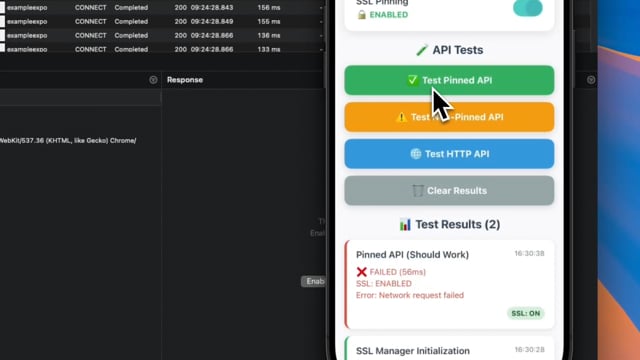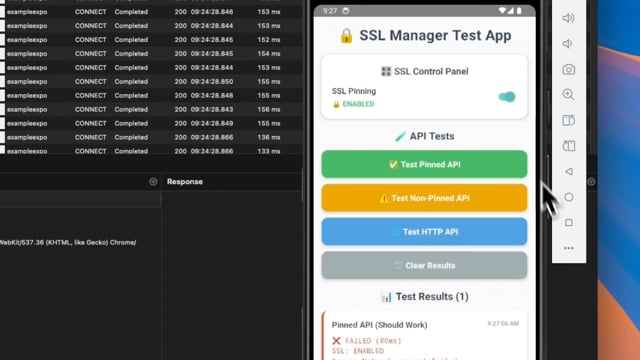react-native-ssl-manager
Version:
React Native SSL Pinning provides seamless SSL certificate pinning integration for enhanced network security in React Native apps. This module enables developers to easily implement and manage certificate pinning, protecting applications against man-in-th
526 lines (396 loc) • 14.3 kB
Markdown
# 🔒 react-native-ssl-manager
**Production-ready SSL certificate pinning for React Native and Expo apps.** This library provides seamless SSL certificate pinning integration for enhanced network security, protecting applications against man-in-the-middle (MITM) attacks. With dynamic configuration options and the ability to toggle SSL pinning, it's perfect for both development and production environments.
## 🎥 Live Demo
### iOS Demo
[](https://vimeo.com/1109299210)
### Android Demo
[](https://vimeo.com/1109299632)
> **📱 Interactive Features Shown:**
> - Toggle SSL pinning on/off
> - Real-time API testing with visual feedback
> - Certificate validation results
> - Performance metrics display
**🎬 Watch Full Demo Videos:**
- **[iOS Demo](https://vimeo.com/1109299210)** - Complete iOS SSL pinning demonstration
- **[Android Demo](https://vimeo.com/1109299632)** - Complete Android SSL pinning demonstration
## ✨ Features
- 🔒 **Easy SSL certificate pinning** - Simple setup with JSON configuration
- 🔄 **Dynamic SSL control** - Enable/disable SSL pinning at runtime
- 🏗️ **New Architecture Ready** - Full support for React Native's New Architecture (Fabric/TurboModules)
- 🏛️ **Legacy Compatible** - Works with both New and Legacy Architecture
- 📱 **Cross-platform** - Native support for iOS & Android
- 🚀 **Expo Compatible** - Built-in Expo plugin with auto-configuration
- ⚡ **Zero Configuration** - Auto-setup with smart fallbacks
- 🧪 **Developer Friendly** - Perfect for development and testing workflows
- 🎯 **Production Ready** - Optimized performance, no debug logs
## 📦 Installation
### For React Native CLI Projects
```bash
# Using npm
npm install react-native-ssl-manager
# Using yarn
yarn add react-native-ssl-manager
# Using bun
bun add react-native-ssl-manager
```
For iOS, run pod install:
```bash
cd ios && pod install
```
### For Expo Projects
```bash
# Using expo CLI
npx expo install react-native-ssl-manager
# Using bun with expo
bunx expo install react-native-ssl-manager
```
Add the plugin to your `app.json` or `app.config.js`:
```json
{
"expo": {
"plugins": [
[
"react-native-ssl-manager",
{
"sslConfigPath": "./ssl_config.json"
}
]
]
}
}
```
## 🚀 Architecture Support
This library supports **both** React Native architectures:
- ✅ **New Architecture** (Fabric/TurboModules) - React Native 0.68+
- ✅ **Legacy Architecture** - All React Native versions
The library automatically detects and uses the appropriate architecture at runtime.
## 🚀 Quick Start
### Step 1: Create SSL Configuration
Create a `ssl_config.json` file in your project root:
```json
{
"sha256Keys": {
"api.example.com": [
"sha256/AAAAAAAAAAAAAAAAAAAAAAAAAAAAAAAAAAAAAAAAAAA=",
"sha256/BBBBBBBBBBBBBBBBBBBBBBBBBBBBBBBBBBBBBBBBBBB="
],
"api.dev.example.com": [
"sha256/CCCCCCCCCCCCCCCCCCCCCCCCCCCCCCCCCCCCCCCCCCC=",
"sha256/DDDDDDDDDDDDDDDDDDDDDDDDDDDDDDDDDDDDDDDDDDD="
]
}
}
```
### Step 2: Basic Usage
```typescript
import { setUseSSLPinning, getUseSSLPinning } from 'react-native-ssl-manager';
// Enable SSL pinning
await setUseSSLPinning(true);
// Check if SSL pinning is enabled
const isEnabled = await getUseSSLPinning();
console.log('SSL Pinning enabled:', isEnabled);
// Disable SSL pinning (for development/testing)
await setUseSSLPinning(false);
```
### Step 3: Test Your Implementation
```typescript
// Test with SSL pinning enabled
await setUseSSLPinning(true);
try {
const response = await fetch('https://api.example.com/data');
console.log('✅ SSL Pinning working - request succeeded');
} catch (error) {
console.log('⚠️ Check your SSL configuration');
}
// Test without SSL pinning
await setUseSSLPinning(false);
const response = await fetch('https://api.example.com/data');
console.log('🔓 Request without SSL pinning');
```
### Configuration File (ssl_config.json)
Create a configuration file with your domain certificates. Example structure:
```json
{
"domains": {
"development": "api.dev.example.com",
"production": "api.example.com"
},
"sha256Keys": {
"api.dev.example.com": [
"sha256/certificate-hash-1=",
"sha256/certificate-hash-2="
],
"api.example.com": [
"sha256/certificate-hash-3=",
"sha256/certificate-hash-4="
]
}
}
```
## 📚 API Reference
### `setUseSSLPinning(usePinning: boolean): Promise<void>`
Enables or disables SSL pinning dynamically.
```typescript
// Enable SSL pinning
await setUseSSLPinning(true);
// Disable SSL pinning
await setUseSSLPinning(false);
```
**Parameters:**
- `usePinning` (boolean): Whether to enable SSL pinning
**Returns:** Promise<void>
### `getUseSSLPinning(): Promise<boolean>`
Retrieves the current state of SSL pinning.
```typescript
const isEnabled = await getUseSSLPinning();
console.log('SSL Pinning enabled:', isEnabled);
```
**Returns:** Promise<boolean> - Current SSL pinning status
## 🔧 Configuration
### SSL Configuration File Structure
**⚠️ Important:** The configuration file **must** be named exactly `ssl_config.json` and placed in your project root directory.
Your `ssl_config.json` should follow this structure:
```json
{
"sha256Keys": {
"your-api-domain.com": [
"sha256/primary-certificate-hash=",
"sha256/backup-certificate-hash="
],
"another-domain.com": [
"sha256/another-certificate-hash="
]
}
}
```
**📁 File Location Requirements:**
- ✅ **React Native CLI**: Place `ssl_config.json` in project root
- ✅ **Expo**: Place `ssl_config.json` in project root (same level as `app.json`)
- ❌ **Don't rename** the file - it must be exactly `ssl_config.json`
- ❌ **Don't place** in subdirectories - must be in project root
## Important Notes ⚠️
### Restarting After SSL Pinning Changes
When using `setUseSSLPinning`, a restart of the application is required for changes to take effect. This is because SSL pinning is implemented at the native level.
#### Using React Native Restart
First, install react-native-restart:
```sh
# Using npm
npm install react-native-restart
# Using yarn
yarn add react-native-restart
```
For iOS, run pod install:
```sh
cd ios && pod install
```
Then use it in your code:
```typescript
import RNRestart from 'react-native-restart';
const toggleSSLPinning = async (enabled: boolean) => {
await setUseSSLPinning(enabled);
// Restart the app to apply changes
RNRestart.Restart();
};
// Example with user confirmation
const handleSSLToggle = async (enabled: boolean) => {
// Save any necessary state
await saveAppState();
// Update SSL pinning
await setUseSSLPinning(enabled);
// Show user message
Alert.alert(
'Restart Required',
'The app needs to restart to apply security changes.',
[
{
text: 'Restart Now',
onPress: () => RNRestart.Restart()
}
]
);
};
```
## Development and Testing Benefits
### For Developers
- **Quick Toggling**: Easily switch SSL pinning on/off during development
- **Performance Optimization**: Minimize SSL verification overhead during development
- **Flexible Configuration**: Support multiple environments with different certificates
### For QA Teams
- **Efficient Testing**: Quickly verify API behavior with and without SSL pinning
- **Issue Investigation**: Easily isolate SSL-related issues
- **Environment Switching**: Seamlessly test across different environments
## Best Practices
1. **Environment Management**
- Keep separate configurations for development and production
- Store production certificates securely
2. **Performance Optimization**
- Enable SSL pinning only when necessary during development
- Use development certificates for testing environments
3. **Security Considerations**
- Always enable SSL pinning in production
- Regularly update certificates before expiration
- Maintain multiple backup certificates
## ✅ Completed Roadmap
### Recently Completed Features
- ✅ **Expo Plugin Integration** - **COMPLETED!**
- ✅ Native SSL pinning support for Expo projects
- ✅ Seamless configuration through expo-config-plugin
- ✅ Auto-linking capabilities for Expo development builds
- ✅ Support for Expo's development client
- ✅ **New Architecture Support** - **COMPLETED!**
- ✅ Full TurboModule implementation
- ✅ Fabric renderer compatibility
- ✅ Automatic architecture detection
- ✅ Backward compatibility with Legacy Architecture
- ✅ **Production Optimizations** - **COMPLETED!**
- ✅ Removed debug logs for production builds
- ✅ Performance optimizations
- ✅ Clean codebase ready for release
## 🚀 Future Roadmap
### Upcoming Features
- 🔄 **Advanced Certificate Management**
- Certificate rotation support
- Automatic certificate validation
- Certificate expiry notifications
- 📊 **Enhanced Developer Experience**
- SSL pinning analytics and monitoring
- Better error reporting and debugging tools
- Integration with popular development tools
- 🔧 **Extended Platform Support**
- Web support for React Native Web
- Additional certificate formats support
## 🧪 Testing Your SSL Implementation
### Using the Example App
This library comes with a comprehensive test app that demonstrates SSL pinning functionality:
```bash
# Clone the repository
git clone https://github.com/huytdps13400/react-native-ssl-manager.git
# Test with React Native CLI
cd react-native-ssl-manager/example
npm install
npm run ios # or npm run android
# Test with Expo
cd ../example-expo
npm install
npx expo run:ios # or npx expo run:android
```
The example app provides:
- 🎛️ **SSL Control Panel** - Toggle SSL pinning on/off
- 🧪 **Multiple Test Scenarios** - Test different API endpoints
- 📊 **Real-time Results** - See detailed test results with timing
- 🔍 **Visual Feedback** - Color-coded success/failure indicators
### Manual Testing Steps
1. **🔓 Test without SSL Pinning:**
```typescript
await setUseSSLPinning(false);
// All API calls should work normally
```
2. **🔒 Test with SSL Pinning (Correct Certificate):**
```typescript
await setUseSSLPinning(true);
// Calls to pinned domains should work
const response = await fetch('https://your-pinned-domain.com/api');
```
3. **⚠️ Test with SSL Pinning (Wrong Certificate):**
```typescript
await setUseSSLPinning(true);
// Calls to non-pinned domains should fail
try {
await fetch('https://unpinned-domain.com/api');
} catch (error) {
console.log('✅ SSL Pinning working - blocked untrusted certificate');
}
```
## Testing with Proxyman 🔍
Proxyman is a powerful tool for testing SSL pinning implementation. Here's how you can verify your SSL pinning configuration:
### Setup Verification
1. **Install Proxyman**
- Download and install [Proxyman](https://proxyman.io/)
- Install Proxyman's SSL certificate on your device/simulator
2. **Testing SSL Pinning**
```typescript
// Enable SSL Pinning
await setUseSSLPinning(true);
// Make API requests through your app
// If SSL pinning is working correctly:
// - Requests will fail when Proxyman tries to intercept them
// - You'll see SSL/TLS handshake errors
// Disable SSL Pinning for debugging
await setUseSSLPinning(false);
// Now you can intercept and inspect API calls with Proxyman
```
### Common Test Scenarios
1. **Verify SSL Pinning is Active**
- Enable SSL pinning
- Attempt to intercept traffic with Proxyman
- Requests should fail with SSL handshake errors
2. **Debug API Calls**
- Disable SSL pinning temporarily
- Use Proxyman to inspect API requests/responses
- Helpful for QA testing and development
3. **Certificate Validation**
- Verify your SSL configuration matches the certificates in ssl_config.json
- Test against both development and production endpoints
### Troubleshooting Tips
- If requests succeed with Proxyman while SSL pinning is enabled, check your configuration
- Verify that the SHA256 hashes in your config match your server certificates
- Test both development and production environments separately
This integration with Proxyman makes it easy to:
- Verify SSL pinning implementation
- Debug API communications
- Validate security configurations
- Speed up development and testing workflows
## 📋 Requirements & Compatibility
### React Native Versions
- ✅ **React Native 0.60+** (AutoLinking support)
- ✅ **React Native 0.68+** (New Architecture support)
- ✅ **Expo SDK 47+** (Expo plugin support)
### Platform Support
- ✅ **iOS 13.0+**
- ✅ **Android API 21+** (Android 5.0)
### Architecture Support
- ✅ **New Architecture** (Fabric/TurboModules)
- ✅ **Legacy Architecture** (Bridge-based)
### Development Tools
- ✅ **React Native CLI**
- ✅ **Expo CLI**
- ✅ **Expo Development Build**
- ✅ **Flipper** (debugging support)
- ✅ **Bun** (package manager support)
## 🤝 Contributing
We welcome contributions! See the [contributing guide](CONTRIBUTING.md) to learn how to contribute to the repository and the development workflow.
### Development Setup
```bash
# Clone the repository
git clone https://github.com/huytdps13400/react-native-ssl-manager.git
cd react-native-ssl-manager
# Install dependencies (choose your package manager)
npm install
# or
yarn install
# or
bun install
# Build the library
npm run build
# or
bun run build
# Run tests
npm test
# or
bun test
# Test with example apps
npm run example:ios
npm run example:android
npm run example-expo:ios
npm run example-expo:android
# Test Bun compatibility
bun run bun:test-compatibility
```
## 📄 License
MIT License - see the [LICENSE](LICENSE) file for details.
## 🙏 Acknowledgments
- Built with [create-react-native-library](https://github.com/callstack/react-native-builder-bob)
- SSL pinning implementation inspired by industry best practices
- Special thanks to the React Native community
---
**Made with ❤️ for the React Native community**